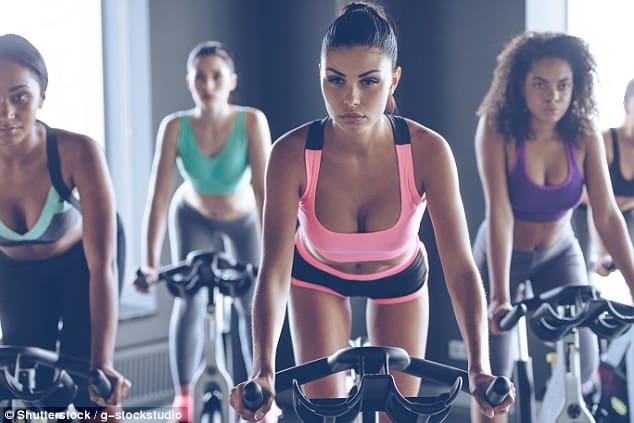Stationary Bicycle is a device used to exercise equipment. It includes a saddle, pedals, and some form of handlebars arranged as on a (stationary) bicycle.
A stationary bicycle is usually a special-purpose exercise machine resembling a bicycle without wheels.
It is also possible to adopt an ordinary bicycle for stationary exercise by placing it on bicycle rollers or a trainer.
Rollers and trainers is sometimes using by racing cyclists to warm up before racing or to train on their own machines indoors.
Stationary Bicycle Exercise: Instructions
Bikes give you less opportunity to use atrocious form than do most other machines. Still, there’s room for injury or discomfort.
Here are some tips to help you avoid both:
Adjust the seat. When the pedal is at the lowest position, your leg should be almost, but not quite, straight.
You shouldn’t have to strain or rock your hips to pedal. Your knees shouldn’t feel crunched when they’re at the top of the pedal stroke.
With a recumbent bike, you adjust the seat forward and back, rather than up and down, but the principles are the same.
Set the handlebars correctly (if your bike allows adjustments). You should be able to hold the bar so that your arms extend out at shoulder level.
You shouldn’t have to squirm around to get comfortable.
Handlebar adjustment is especially important if you’re very tall or very short.
Get to know the display panel. For instance, notice how many levels the bike has. Some bikes feature 12 levels; others have 40.
So if you just hop on and press Level 6, you’ll get two very different workouts.
Also, pay attention to your cadence — that is, how many revolutions per minute (rpm) you’re cycling. Varying your cadence is a good idea.
You may want to hum along at 80 rpm for 5 minutes and then do 30-second intervals at 100 rpm using the same tension level.
Adjust the pedal straps so that your feet feel snug — but don’t let the straps cut off your circulation.
Riding a bike with the foot straps is much more comfortable and efficient than pedaling without them.
Don’t remove the pedal straps from your bike; this forces the next person to waste time putting them back on.
Don’t pedal with just your toes. Otherwise, you may bring on foot and calf cramps.
Instead, press from the ball of your foot and through your heel as you pump downward on the pedal, and pull up with the top of your foot on the upstroke.
Don’t hunch over. Rounding your back is the way to develop back and neck pain. Don’t get your upper body into the effort, either.
Instead, keep your chest up, shoulders back and down, ears in line with your shoulders, and the belly button is drawn in.
Unlike some other machines, riding a stationary bike is not a total-body workout; don’t try to make it one.
If you have to rock wildly from side to side, grit your teeth, or clench the handlebars, you need to lighten your load.
Benefits
WEIGHT LOSS
If you’re looking to shed some pounds, an exercise bike is a very efficient way to burn calories. Riding a stationary bike for 30 minutes at a time can burn anywhere between 200-300 calories (depending on the user’s weight).
TONING
Cyclists are known for having amazing legs. It makes sense: when you’re pedaling away on a bike, your quads, glutes, and calves are hard at work propelling the bike. Bonus: if you’re working that handlebar, you’re giving your upper body a workout, too.
MUSCLE STRENGTHENING
Stationary bikes work tirelessly to strengthen the major muscle groups that support the back, leg, thigh, and hamstring muscles. There are 2 different strokes that are used on an exercise bike: the push and the pull. Pushing down on the pedals is a great way to strengthen the quads, while pulling up is a great way to strengthen the hamstrings. Bonus: exercise bikes cause less stress on the knees than outdoor bikes since you’re riding on even terrain.
EASE ON THE JOINTS
Running, jogging, and many team sports and classes can be hard on your joints because of the amount of impact involved. An exercise bike is an exceptional way to get your heart rate up without putting excess stress on those precious joints. In fact, a bike puts even less stress on the back, hips, knees and ankles than walking. Proper form on the bike means your knee should bend just slightly on the down pedal stroke. If it’s too bent or too straight, you’ll need to adjust that saddle.
CONVENIENCE
The best part about an exercise bike is that you can use it whenever, wherever. If the weather outside is too hot, too cold, or too rainy, who cares? You can keep a recumbent bike in your home office, bedroom, or patio, giving you the chance to work out after dinner, before breakfast, or during a break at work. Plus, when you’re on your machine, you can catch up on your favorite TV shows, read the newspaper or a book, or keep an eye on your little ones.
CARDIO
Cardio exercise works to lower high blood pressure, regulate blood sugar, and prevent heart attacks. Not to mention, it’s a great way to lose weight. Hopping on an exercise bike is an exceptional way to work your body because it will help your heart become more efficient at pumping blood. It also works hard to increase the good cholesterol and lower the bad cholesterol in your body. To put it simply, riding an exercise bike for 30 minutes a day for a handful of times per week can extend your life.
HEART AND HEALTH BENEFITS
Riding an exercise bike can strengthen your heart and lungs, while also improving your body’s ability to utilize oxygen. Using a stationary bike regularly can also help regulate high blood pressure and improve respiratory function. For best results, it’s recommended that you exercise five days a week for 30 minutes.
ENERGY-BOOSTING
According to a study published in the journal Psychotherapy and Psychosomatics, bike riding improved energy levels by 20 percent and decreased fatigue by 65 percent. Why do you ask? It’s simple: cycling triggers your brain to release the neurotransmitter dopamine, which is linked to energy.














Trackbacks/Pingbacks